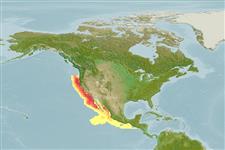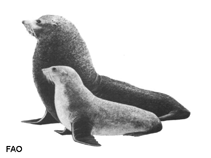Arctocephalus townsendi Merriam, 1897
Guadalupe fur seal| Native range | All suitable habitat | Point map | Year 2050 |

|
| This map was computer-generated and has not yet been reviewed. |
| Arctocephalus townsendi AquaMaps Data sources: GBIF OBIS |
Classification / Names Common names | Synonyms | CoL | ITIS | WoRMS
Mammalia | Carnivora | Otariidae
Environment: milieu / climate zone / depth range / distribution range Ecology
Bathydemersal. Subtropical; 45°N - 13°N, 140°W - 180°E
Distribution Countries | FAO areas | Ecosystems | Occurrences | Introductions
Eastern Central Pacific: USA and Mexico.
Length at first maturity / Size / Weight / Age
Maturity: Lm ? range ? - ? cm Max length : 190 cm TL male/unsexed; (Ref. 1394); 140 cm TL (female); max. published weight: 170.0 kg (Ref. 1394); max. published weight: 170.0 kg
Short description Morphology
Dusky black with lighter ventrum. Gray head and shoulders, black nose with brown-red hair around the eyes. Guard hairs are white-tipped in adult males. Claws present in 5 fingers and absent on the 1st and 5th toes. Cartilaginous webbing extends past the claws. Females have 2 pairs abdominal nipples.
Found at sea, on beaches; when ashore, they prefer volcanic caves and grottos, or other rocky habitats. Found at sea, on beaches; when ashore, they prefer volcanic caves and grottos, or other rocky habitats. Both male and female territorial. Extralimital sightings in California corresponds with El Niño events (Ref. 1394).
Life cycle and mating behavior Maturity | Reproduction | Spawning | Eggs | Fecundity | Larvae
Breeds near or in caves marked by the male as his territory. Mating occurs postpartum. Pups nurse for 9 to 11 months during which nursing females fast for an average of 5 days.
Main reference
References | Coordinator | Collaborators
Jefferson, T.A., S. Leatherwood and M.A. Webber. 1993. (Ref. 1394)
IUCN Red List Status (Ref. 130435)
Least Concern (LC) ; Date assessed: 10 October 2014
CITES status (Ref. 108899)
Appendix I: International trade banned
CMS (Ref. 116361)
Not Evaluated
Threat to humans
Human uses
Fisheries: commercial
FAO - Fisheries: species profile | FishSource | Sea Around Us
Tools
More information
Internet sources
BHL | BOLD Systems | CISTI | DiscoverLife | FAO(Fisheries: species profile; publication : search) | Fishipedia | GenBank (genome, nucleotide) | GloBI | Gomexsi | Google Books | Google Scholar | Google | PubMed | Tree of Life | Wikipedia (Go, Search) | Zoological Record
Estimates based on models
Preferred temperature
(Ref. 115969): 2.1 - 4, mean 3.1 (based on 48 cells).
Price category
(Ref. 80766):
Unknown.



